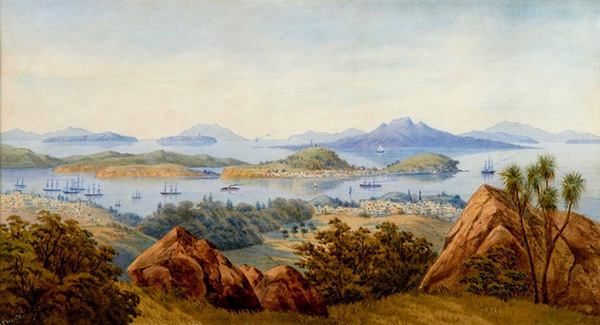Jade River: A History of the Mahurangi
Ronald H LockerFirst published 2001. Published online 2014–. This online edition is a work in progress…
Pages 146–147in printed edition
Early end to 1800s Mahurangi boatbuilding

Needless Perplexity: Dr Ronald Locker puzzles over why its once-illustrious shipbuilding industry forsook the Mahurangi for Auckland, by 1880, but, as this circa 1870 scene suggests, nearby Auckland by then would have been a far more competitive place for the industry, given that port’s size, steam-powered sawmills, foundries, and specialist labour force—shipbuilding was sufficiently laborious without also having to convert logs to boards by hand. watercolour John Barr Clarke Hoyte
This substantial boatbuilding activity at Mahurangi declined in the late seventies and died in 1880.
The reasons do not appear to be local. It was not due to lack of human or material resources. The original major builders had died or grown old, but they had passed on their skills. The most easily accessible local timber had been taken, but there was still enough available in the Mahurangi or close by.
An indication of hard times for the local shipwrights is that in 1880, David Darrach and Rufus Dunning both put in tenders for the construction of the first wharf at Scotts Landing, but lost out to regular contractor, William McElroy senior. The shipbuilding slump had struck earlier at Mangawhai. ‘Our Rambling Reporter’ wrote on 1 April 1876:
At the Heads Mr McInnis has a large shipbuilding yard from which some fine vessels have been turned out; at present nothing is doing in the way of shipbuilding, so that silence reigns over this part of Mangawhai.
The yard built its last vessel in 1875, in line with the end of shipbuilding at Matakana in 1874, and Waiwera in 1876.
The reasons for the decline must be sought on the wider scene, but even here a definitive answer escapes me. New Zealand was sliding into deep depression, in the face of declining world prices for agricultural produce. This had begun in 1877 and persisted until 1895. It had struck early and hard in the South Island, dependent on agriculture, and precipitated bank crises. But in Auckland, where agriculture was primitive and timber was king, there was actually a boom, on borrowed money, through the early 1880s. New companies were floated; office and suburban building flourished. Timber production peaked in 1883. This should have meant work for Mahurangi vessels. It is true that exports of timber were rising, employing large foreign barques, loading directly on the Wairoa and elsewhere. But in 1880 only a sixth of production was exported, leaving plenty for local traffic. Trade with the Pacific Islands was also thriving. One important trade had collapsed by 1880: the timber-south-and-grain-north trade to the South Island, in which Shorts’ and some of Darrachs’ ships had been involved. The great business collapse of 1885–6, taking down most of the merchant princes of Auckland, came a decade too late to explain decline in Mahurangi.
On the New Zealand coast, competition from steam had been increasing steadily through the seventies, taking cargo and passengers from sail, which could not compete in regularity or comfort. The big competitor, the Northern Steamship Company, did not emerge until 1881, but it was a fusion of existing profitable steamboat syndicates. Casey already had fleets of steamers on both the Kaipara and the Hauraki Gulf. His pride, the Rose Casey, was serving the Mahurangi by 1878.
Despite these adverse factors, the demise of sail as economic transport was a long way off. The construction of deep-draught sailing vessels continued in Auckland and large yards elsewhere, well into the next century. There was an emphasis in the last quarter of the nineteenth century, on fast, island trading schooners, a trend already evident in Darrachs’ later vessels. The steam sawmills of Auckland, its smithies and foundries, gave boatbuilders in the capital more of an economic edge in worsening times, and welcome new work in the construction of wooden steamboats.
The surge in scow building was just beginning, but went to Ōmaha and Auckland. The scows succeeded in the face of steam by taking on the donkey work: logs, coal, firewood, sand and shingle, cement and cattle. Many of the cargoes were loaded off beaches and mudflats, and many came from the Mahurangi. The loss of the scow Ranginever engined in 1937 marked the end of working purely under sail. A small flotilla of scows went to fight the war in the Pacific, and few returned. The last working scow was, appropriately, one built by Davey Darroch, the Mahurangi boy who made scow-building his career. The Jane Gifford1908 worked out of Warkworth under Reg Collins in the years 1916–37. She was retired by Bert Subritzky in 1985, after 77 years of service, and a century after Davey launched his first scow at Ōmaha. The Jane Gifford was restored at Waiuku and re-launched in 1993.
Even the Northern Steamship Company saw the economies of sail. Between 1912 and 1920 it commissioned eight auxiliary schooners and ketches, and owned three more, although I am told there were considerable economies in insurance rates involved here.
Restoration revisited The Waiuku restoration was insufficient the prevent the Jane Gifford again falling into disrepair, and she was returned to her one-time home port of Warkworth in 2005, where her hull was rebuilt using pressure-treated radiata pine. She was also resparred and re-engined, before her relaunch in 2009.
